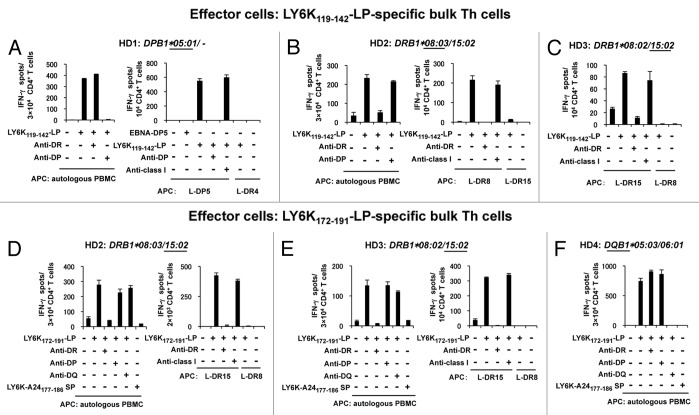Figure 1. Induction of LY6K-specific helper T cells from healthy donors. (A–F) LY6K-specific helper T (Th) cells were generated from healthy donors (HDs) by stimulating purified CD4+ cells with LY6K119–142-LP or LY6K172–191-LP, as indicated. The number of IFNγ-producing Th cells was analyzed by ELISPOT assay. Data are presented as the mean ± SD of triplicate assays. The HLA class-II genotype is indicated above the panels. The underlined HLA-Class II allele encodes the element presenting the peptides to Th cells. (A) Induction of HLA-DP5-restricted LY6K119–142-LP-specific Th cells in donor HD1. Data are from at least 3 independent experiments with representative results shown. The Th cells were restimulated with autologous peripheral blood mononuclear cells (PBMCs; left panel) or L-cells (engineered to express the indicated HLA molecule) pulsed with LY6K119–142-LP antigen presenting cells (APCs; right panel). An Epstein‒Barr virus-derived nuclear antigen (EBNA-DP5 LP) was used as a control LP. B-F. Induction of HLA-restricted LY6K119–142-LP (B and C) or LY6K172–191-LP (D–F) specific Th cells, similar to (A) (above). (B) Induction of HLA-DR8-restricted LY6K119–142-LP-specific Th cells in donor HD2. (C) Induction of HLA-DR15-restricted LY6K119–142-LP-specific Th cells in donor HD3. (D and E) HLA-DR15-restricted LY6K172–191-LP-specific Th cells were generated from HD2 and HD3. (F). HLA-DQ-restricted LY6K172–191-LP-specific Th cells were generated from a DR15-negative HD4. LP, long peptide.

An official website of the United States government
Here's how you know
Official websites use .gov
A
.gov website belongs to an official
government organization in the United States.
Secure .gov websites use HTTPS
A lock (
) or https:// means you've safely
connected to the .gov website. Share sensitive
information only on official, secure websites.
